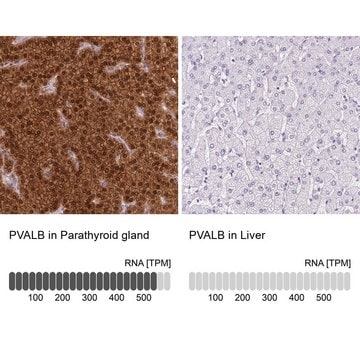AB15736
Anti-Parvalbumin Antibody
serum, Chemicon®
Zaloguj sięWyświetlanie cen organizacyjnych i kontraktowych
About This Item
Kod UNSPSC:
12352203
eCl@ss:
32160702
NACRES:
NA.41
Polecane produkty
pochodzenie biologiczne
rabbit
Poziom jakości
forma przeciwciała
serum
rodzaj przeciwciała
primary antibodies
klon
polyclonal
reaktywność gatunkowa
human
producent / nazwa handlowa
Chemicon®
metody
immunohistochemistry: suitable (paraffin)
numer dostępu NCBI
numer dostępu UniProt
Warunki transportu
wet ice
docelowa modyfikacja potranslacyjna
unmodified
informacje o genach
human ... PVALB(5816)
Specyficzność
Parvalbumin. Immunoreactivity is seen primarily in Purkinje cells. Immunostaining is completely eliminated when the antibody is incubated with the immunogen peptide prior to staining.
Immunogen
Synthetic peptide.
Zastosowanie
Immunohistochemistry: 1:100 on paraffin embedded, 10% neutral Buffered Formalin fixed human cerebellum tissue. Suggested pretreatment is HIER (Heat Induced Epitope Retrieval) using Citrate buffer, pH 6.0. Detection system was the IHC-Select HRP-DAB system.
Research Category
Neuroscience
Neuroscience
Research Sub Category
Signaling Neuroscience
Signaling Neuroscience
This Anti-Parvalbumin Antibody is validated for use in IH(P) for the detection of Parvalbumin.
Powiązanie
Replaces: AB9312
Postać fizyczna
Liquid.
Serum
Przechowywanie i stabilność
1 year at -20°C from date of shipment
Informacje prawne
CHEMICON is a registered trademark of Merck KGaA, Darmstadt, Germany
Oświadczenie o zrzeczeniu się odpowiedzialności
Unless otherwise stated in our catalog or other company documentation accompanying the product(s), our products are intended for research use only and are not to be used for any other purpose, which includes but is not limited to, unauthorized commercial uses, in vitro diagnostic uses, ex vivo or in vivo therapeutic uses or any type of consumption or application to humans or animals.
This page may contain text that has been machine translated.
Not finding the right product?
Try our Narzędzie selektora produktów.
polecane
Kod klasy składowania
10 - Combustible liquids
Klasa zagrożenia wodnego (WGK)
WGK 1
Temperatura zapłonu (°F)
Not applicable
Temperatura zapłonu (°C)
Not applicable
Certyfikaty analizy (CoA)
Poszukaj Certyfikaty analizy (CoA), wpisując numer partii/serii produktów. Numery serii i partii można znaleźć na etykiecie produktu po słowach „seria” lub „partia”.
Masz już ten produkt?
Dokumenty związane z niedawno zakupionymi produktami zostały zamieszczone w Bibliotece dokumentów.
Daniel E Winkowski et al.
Cerebral cortex (New York, N.Y. : 1991), 28(3), 868-879 (2017-01-11)
Sensory environments change over a wide dynamic range and sensory processing can change rapidly to facilitate stable perception. While rapid changes may occur throughout the sensory processing pathway, cortical changes are believed to profoundly influence perception. Prior stimulation studies showed
Neuroprotective effect of ginseng against alteration of calcium binding proteins immunoreactivity in the mice hippocampus after radiofrequency exposure.
Maskey, D; Lee, JK; Kim, HR; Kim, HG
BioMed Research International null
Julia Ahlfeld et al.
Scientific reports, 7(1), 6137-6137 (2017-07-25)
We identified a rare undifferentiated cell population that is intermingled with the Bergmann glia of the adult murine cerebellar cortex, expresses the stem cell markers Sox2 and Nestin, and lacks markers of glial or neuronal differentiation. Interestingly, such Sox2+ S100-
Pedro Royero et al.
Cell reports, 41(10), 111757-111757 (2022-12-09)
Maintaining an appropriate balance between excitation and inhibition is critical for neuronal information processing. Cortical neurons can cell-autonomously adjust the inhibition they receive to individual levels of excitatory input, but the underlying mechanisms are unclear. We describe that Ste20-like kinase
Yoshifumi Matsumoto et al.
Frontiers in molecular neuroscience, 17, 1386924-1386924 (2024-05-13)
The Slitrk family consists of six synaptic adhesion molecules, some of which are associated with neuropsychiatric disorders. In this study, we aimed to investigate the physiological role of Slitrk4 by analyzing Slitrk4 knockout (KO) mice. The Slitrk4 protein was widely
Nasz zespół naukowców ma doświadczenie we wszystkich obszarach badań, w tym w naukach przyrodniczych, materiałoznawstwie, syntezie chemicznej, chromatografii, analityce i wielu innych dziedzinach.
Skontaktuj się z zespołem ds. pomocy technicznej








